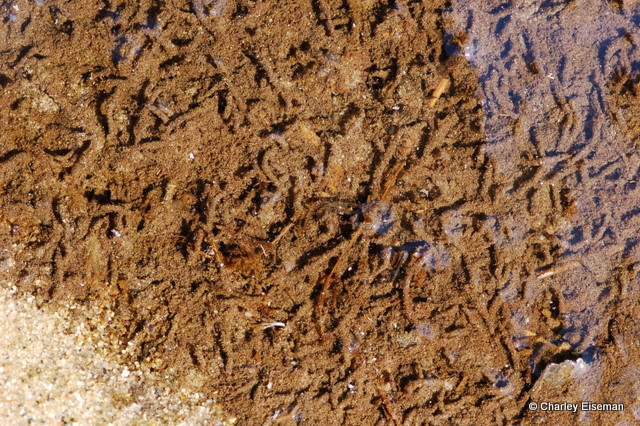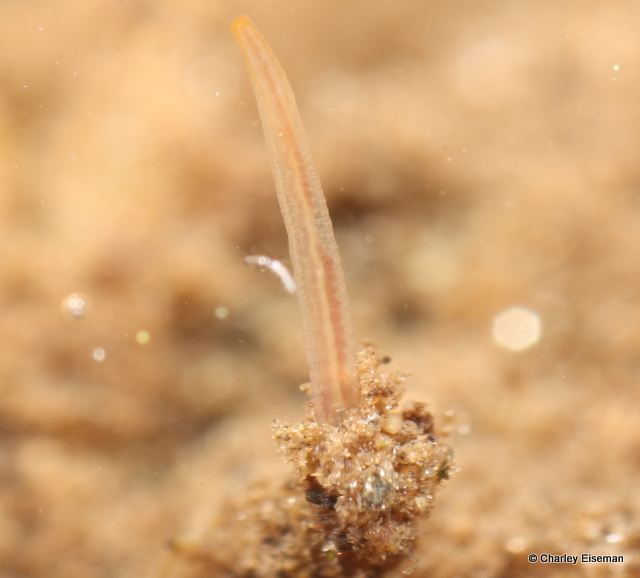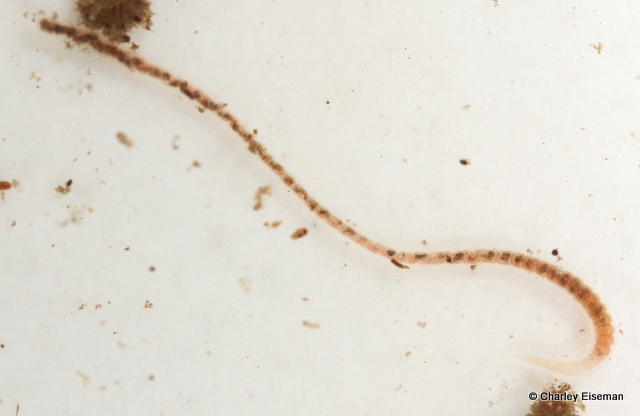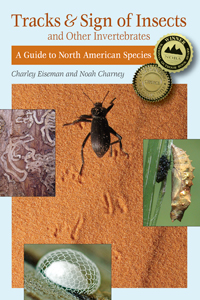Last night as I was sorting through various tiny wasps and things and getting them ready to send to the USDA Systematic Entomology Lab for identification, I wondered what ever happened to that worm I sent to Sweden back in April. It all started last July, when I was walking along the dirt road under the power lines in the woods near my house. There is a point where a seep forms little trickling puddles in the road, and in one of these puddles I noticed this aggregation of sprawling tubes made of sediment:
The tubes were 1.5 mm thick and up to 15 mm long. My gut feeling was that they were made by some kind of worm–the alternatives being caddisfly larvae or fly larvae; see pp. 265-7 of Tracks & Sign of Insects–but the only option I knew of was some kind of sludge worm (Naididae*), which didn’t seem like a good fit. For one thing, this wasn’t stagnant water; for another, the literature and annelid (segmented worm) specialists I had consulted in my research all agreed that freshwater naidid tubes are no more than 5 mm high. So I sat and watched a bit, and before long, I did in fact see some wormy little faces peeking out of the tubes.
Realizing that worms are not something you can expect anyone to identify from a photograph, I scooped one up–this took several tries, since they quickly retreated into their burrows when disturbed–and put it in a vial to send to a specialist.
The worm sat on my desk until December, when I finally got around to posting a question about it on the Annelida List. People had a few different ideas about what it was, but Christer Erséus of Sweden seemed most confident of his impression, and he offered to analyze its DNA, which seemed like it might be the only hope–it coiled up and broke into several pieces when I collected it, so it was in pretty sorry shape. Four months later, I finally got around to sending it to him, and he mentioned there was a backlog of worms awaiting DNA barcoding, so I didn’t expect a quick answer. Last night I wrote to him to check in, and he replied this morning: his technician was unable to get a DNA barcode from it (no doubt because I let it sit around for so long before sending it to him), but he had just now looked at a chunk of it and confirmed his initial impression that it was a naidid in the genus Aulodrilus. He said it seemed to be A. pluriseta or A. japonicus, which some (including him) believe to be two names for the same species. I found a paper about A. japonicus in the Netherlands here, which considers the two to be distinct species but the study didn’t find any ecological differences between the two other than that A. japonicus was much more abundant. They are found in a variety of aquatic habitats, preferring silty substrates. Like other naidids, they feed on decaying organic matter by extending their front ends from their tubes. There doesn’t seem to be too much more to say about them, other than that in my mythical second edition, I would clarify that the term “sludge worm” –and the bit about stagnant water and 2-5 mm tubes–really refers just to members of the genus Tubifex, rather than to the whole family Naididae, and that Aulodrilus species can have much larger tubes and occur in other habitats.
* This family was long known as Tubificidae, but the name was changed recently, as explained here.








Can they grow on or just under human skin?
Definitely not.
Dear Charley, thanks a lot for this article! I am working on benthic habitat classification using video images from Lake Erie, and seeing many tubes on the bottom are now trying to track them back to species (I have a list from actual samples, and Aulodrilus is one of them). Aulodrilus densities had high correlation with tube abundance in images, so I was trying to specifically check what kind of tubes they build and found your article! Thanks again for your curiosity and your persistence in finding the answers!! Sincerely, Lyuba
Glad to hear it was helpful!